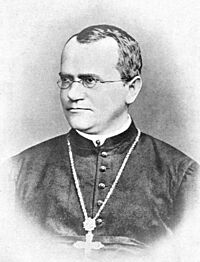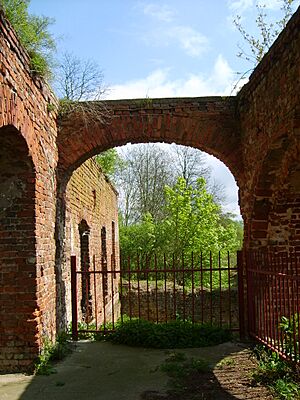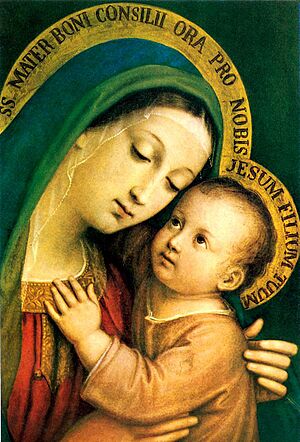Augustinians facts for kids
Augustinians are members of different religious orders in the Catholic Church. They all follow a special set of guidelines called the Rule of Saint Augustine. This rule was written around 400 A.D. by a famous saint named Augustine of Hippo.
There are two main types of Augustinians that started a long time ago, between the 12th and 13th centuries:
- Canons Regular: These are priests who live together in communities. They follow Augustine's Rule and focus on helping people in parishes. They often serve nearby churches.
- Friars: These are brothers who live a mix of quiet prayer and active service. The biggest group is the Order of Saint Augustine (OSA), started in 1244. They are sometimes called the Austin Friars. Other groups like the Order of Augustinian Recollects and the Discalced Augustinians also came from this main order.
Some Anglican religious orders, which started in the 1800s, also follow Augustine's rule. These are only for women, in different communities of Augustinian nuns.
Contents
What Makes Augustinians Special?
In religious groups, "charism" means the special way each group and its members contribute to the world. For Augustinians, their special way of life comes from the teachings of Saint Augustine. It also comes from the Augustinian Rule and the experiences of Augustinians over many centuries.
Augustinians believe in finding truth through learning. They also believe in treating each other with love. These ideas of love and fairness have guided them in their work around the world. This balance of love and learning helps them build communities. These communities are based on caring for each other and growing in knowledge.
Augustine loved beauty, especially music. He taught that "whoever sings prays twice." Music is a very important part of the Augustinian way of life. Today, Augustinian churches like the Augustinerkirche in Vienna have beautiful music. They perform works by famous composers like Mozart and Schubert. The boys' choir at Sankt Florian in Austria, run by Augustinian canons, is over 1,000 years old.
Augustinians have also written many important scholarly books.
How the Augustinians Started
Augustinian friars believe that Augustine of Hippo lived a community life. First, he lived with friends, and later, as a bishop, he lived with his priests. Augustine taught that sharing was important, not just being poor. Other people started to copy their way of life.
Augustine's writings, especially De opere monachorum, gave instructions for this lifestyle. This writing became known as the "Rule of St. Augustine." Between 430 and 570, this way of life spread to Europe. Monks and priests fleeing persecution helped carry it there.
In the 13th century, different groups of hermits used Augustine's rule. The rule was used by many groups across Europe.
While other rules, like the Rule of Saint Benedict, were more popular for a time, Augustine's rule continued. It was used by cathedral priests who lived in communities. These priests became known as Canons regular. In the 11th century, Augustine's Rule became important again. It helped reform monasteries and cathedral groups.
Many groups of canons adopted Augustine's Rule. This included the Canons Regular of the Abbey of St. Victor in Paris. The instructions in Augustine's Rule became the basis for the Rule adopted by canons. They wanted to live a common life, like the early apostles. This is why they are called Canons Regular of Saint Augustine.
Different Augustinian Groups
Canons Regular
The Canons Regular follow an older form of religious life. It developed around the year 1000. They are priests who live in communities. They added religious vows to their main job of helping people as pastors. As they became more independent, they formed their own communities.
Examples of Augustinian canons regular include the Canons Regular of Premontre and the Canons Regular of the Lateran.
Augustinian Friars


The Order of Saint Augustine (OSA) includes:
- Friars: These are brothers, including priests and those preparing to be priests.
- Nuns: These are contemplative sisters who live in monasteries.
- Lay people: These are people who are not priests or nuns but are part of Augustinian groups.
The Augustinian friars (OSA) are a mendicant order. This means they rely on donations and live simply. They pray throughout the day. Unlike older monastic orders, they do not stay in one house forever. They can move to different communities. They also do active work like mission work, teaching, and helping in prisons.
The order is led by a Prior General in Rome. It has different areas called Provinces around the world. Each Province has a Prior Provincial. Augustinians also promise to live simply as a community.
Augustinians promise to live chastely, in poverty, and to obey. They follow the Rule of St. Augustine. This rule was written for a community Augustine started in Hippo. It is inspired by the early Christians who shared everything they had.
The Augustinian Order is directly connected to the Pope. This means bishops do not control their internal matters.
History of the Friars
The Augustinian friars started after the older Canons Regular. They were part of a new movement in the 13th century. This movement wanted to bring religious life into cities. This allowed religious people to help others more directly. Many small groups of hermits lived in different places in Europe. A Church meeting in 1215 asked these groups to live in communities and follow a rule.
The First Union (1244)
In 1243, hermits from Tuscany asked Pope Innocent IV to unite them. On December 16, 1243, Pope Innocent IV issued a special letter. This letter started the Augustinian Order as we know it today. It asked these hermits to follow the Rule of Augustine. It also told them to choose a leader called a Prior General.
In March 1244, these hermits met. They formally adopted the Rule of St. Augustine. They also decided to choose a Prior General every three years. The Pope officially approved the order in March 1244.
The Grand Union of 1256
In 1255, Pope Alexander IV called all Augustinian hermits to Rome. In 1256, many different groups of hermits joined together. These included the Hermits of Saint William and the Bonites.
At this meeting, Lanfranc Settala was chosen as the Prior General. The black robe of the Tuscan hermits became the common clothing. The order, which was only 12 years old, now had over 100 houses.
On April 9, 1256, Pope Alexander IV confirmed this big union. The order was officially called the Order of Hermits of Saint Augustine. Soon, the name "hermits" was not quite right. They became known as friars, like the other mendicant orders.
In their early years, the order focused on learning, prayer, and helping the poor. They also defended the Pope and the Church. A historian from the 14th century, Jordan of Saxony, wrote about their work. He said they focused on singing prayers, serving at the altar, studying the Bible, teaching, preaching, and hearing confessions.
The order grew beyond Europe. They even had a place in Acre before it was conquered in 1291. In the 1300s, they had a large convent in Heraklion.
Augustinians have had many saints and blessed members.
Special Rights of the Order
The Augustinian order received special rights from the Church. Pope Alexander IV freed the order from the control of local bishops. This means they answered directly to the Pope.
Since the late 1200s, the person in charge of the Papal Palace's sacred items was always an Augustinian friar. This person was also a bishop. This job included keeping a special consecrated Host ready for the Pope. The sacristan also traveled with the Pope and celebrated Mass during special meetings. Augustinian friars still do some of these duties today.
Augustinian friars also held teaching positions at the Sapienza University in Rome.
Discalced and Recollect Friars
The Discalced Augustinians started in Italy in 1588. They were a reform movement within the order. The Augustinian Recollects started in Spain in 1592 with a similar goal. Today, they mainly focus on helping people in parishes.
How the Order is Organized
The Augustinian Hermits follow the Rule of St. Augustine. They also follow their own rules called Constitutions. These were first written around 1298. They have been updated several times, most recently in 2007.
The order is led by a Prior General. This leader is chosen every six years. The Prior General has assistants and a secretary. Each region, called a province, is led by a Prior Provincial. Each monastery has a Prior.
Augustinians include both priests and lay brothers. They also have a Cardinal Protector, a cardinal who supports their order.
The Rule of St. Augustine has eight chapters. These cover topics like common life, prayer, moderation, chastity, caring for goods, forgiveness, and obedience. Augustinians also use their "charism," or special gift from the Holy Spirit, to guide their community life.
The friars wear a black woolen robe with long, wide sleeves. They have a black leather belt and a large shoulder cape with a pointed hood. In some places, they used to wear white. In hot climates, Augustinians often wear white robes.
Special Focus of the Order of St. Augustine
The main idea of Augustinian life is living together in community. This includes a quiet, prayerful side.
Other Augustinian Groups
Many other religious orders and groups are part of the Augustinian family. They either follow the Rule of Augustine or are formally connected to the main order. Some of these include:
- The Hieronymites
- The Ursulines
- The Augustinians of the Assumption
- The Alexian Brothers
- The Sisters of Charity of the Incarnate Word
- The Brothers Hospitallers of Saint John of God
- The Bridgettines
Augustinian Lay Societies
Lay societies are groups of people who are not priests or nuns. They might be married or single. They support the Augustinian way of life. These lay people do not take religious vows. Instead, they help the Augustinian Order through volunteer work, donations, and by promoting the teachings of St. Augustine.
The main lay groups are the Third Orders. These are the Augustinian Lay Community and the Secular Augustinian Recollects. They make a formal promise to follow the spirit of the Order as best they can.
Other groups that support the friars and sisters include the Brotherhood of the Virgin Mary of the Belt in Italy.
Special Prayers and Practices
Augustinians have special prayers and practices they encourage. One is honoring the Blessed Virgin Mary as "Mother of Good Counsel" (Mater Boni Consilii). A miraculous picture of her is in an Augustinian church in Italy. This devotion has spread to many places.
Augustinians also traditionally promoted the Archconfraternity of Our Lady of Consolation. Members wear a blessed sash or belt. They pray daily and fast on the eve of St. Augustine's feast day. This group was started in 1439.
Many places are dedicated to Mary as Our Lady of Grace. For example, the Canadian Augustinians have the Marylake Shrine of Our Lady of Grace in Ontario.
Saints and Blessed Augustinians
- Saint Fulgentius of Ruspe (died 527)
- Saint Clare of Montefalco (died 1308)
- Saint John of Sahagún (died 1479)
- Saint John Stone (died 1539)
- Saint Alonso de Orozco Mena (died 1591)
- Saint Bartholomew Gutierrez (died 1632)
- Saint Thomas ‘Kintsuba’ Jihyoe of Saint Augustine (died 1637)
- Saint Nicholas of Tolentino (died 1305)
- Saint Rita of Cascia
- Saint Thomas of Villanova (died 1555)
- Saint Peter Zúñiga (died 1622)
- Blessed Clemente da Osimo (died 1291)
- Blessed James of Viterbo (died 1307)
- Blessed Agostino Novello (died 1309)
- Blessed Antonio Patrizi (died 1311)
- Blessed Angelo da Foligno (died 1312)
- Blessed Simon Rinalducci (died 1322)
- Blessed Angelo da Furci (died 1327)
- Blessed Gregorio Celli (died 1343)
- Blessed Simon of Cascia (died 1348)
- Blessed Gundisalvus of Lagos (died 1422)
- Blessed William Tirry (died 1654)
- Blessed Anne Catherine Emmerich (died 1824)
- Blessed Stefano Bellesini (died 1840)
- Blessed Mariano de la Mata (died 1983)
- Venerable Alphonse Gallegos (died 1991)
See also
- Augustinian nuns
- Augustinian nuns in the Anglican Communion
- Holy Jesus Hospital
- Independent Augustinian Communities
- Pope Leo XIV
- Mercedarians
- Order of Aubrac
- Order of Augustinian Recollects
- Order of the Canons Regular of Premontre
- Our Lady of Good Counsel
- Society of Saint Augustine



